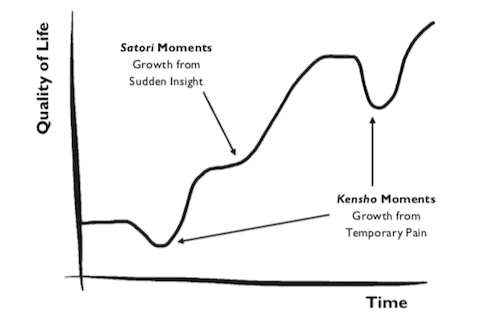Hi there,
There’s a concept I came across years ago that completely changed how I think about personal growth. And trust me, after interviewing thousands of the world’s greatest thinkers, that’s saying something.
It comes from Zen Buddhism, and it suggests that from the moment we’re born until the day we die, there’s a force pushing us to grow.
Now, this force can be gentle—like the hand of a close friend on your back, guiding you through an open door. Or it can be violent—like the universe smacking you in the face with a two-by-four.
It all depends on one thing: How closely are you listening?
I first heard this idea from Michael Beckwith, the founder of the Agape International Spiritual Center and the creator of Mindvalley’s Life Visioning Mastery program. In one of our many conversations, he explained how we grow through two distinct experiences:
Kensho and Satori.
This idea is so powerful that once you understand it, you’ll never look at struggles, setbacks, or unexpected breakthroughs the same way again.
Let’s dive in.
The universe can help you grow in two ways
Imagine this:
You’re living your life, going through the motions, when suddenly—BAM!
You lose your job.
Your relationship crumbles.
Your health takes a hit.
Your business collapses.
That’s what Michael calls a Kensho moment—growth through pain.
Kensho moments are the wake-up calls we never asked for but desperately need. They’re the moments of heartbreak, loss, or failure that force us to evolve. They’re painful, but they lead to breakthroughs.
Then there are Satori moments. These are the flashes of insight—the “aha!” moments—that shift our perception instantly. They come from deep meditation, personal growth experiences, or profound realizations.
For example:
- You attend a Mindvalley seminar, and in one session, your entire worldview changes.
- You read a book, and it unlocks a whole new level of understanding.
- You experience a deep, altered state—through breathwork, meditation, or even plant medicine—and suddenly, life makes sense in a way it never did before.
The difference between Kensho and Satori
- Kensho = Growth through pain (illness, heartbreak, financial struggle, failure)
- Satori = Growth through insight (meditation, learning, sudden realizations)
If you’re deeply engaged in your own personal growth, you’ll experience more Satori moments—and fewer Kensho moments.
But here’s the problem: Most people aren’t listening.
Most people live life on a hamster wheel, too busy, distracted, or stuck in routine to actively seek out growth. And when you don’t create space for Satori moments, the universe will push you differently—through Kensho.
Kensho: The Universe’s tough love
Kensho is a gradual process that often happens through the tribulations of life. A relationship breaks up, but you learn from it and your heart becomes more resilient. You lose a business, but you use the hard-earned wisdom to start your next one. You lose your job, but you learn who you are beyond your career. You suffer a health problem, but you discover personal reserves you didn’t know you had.
Kensho is the universe giving you tough love.
Most of the time, we don’t even realize it’s happening. Imagine the tectonic shifts of the continents—we can’t see them in real time, but when we map them over centuries, we see that the entire world has changed.
That’s what Kensho is doing to you.
At the time, it feels like life is falling apart.
But looking back, you realize that these painful moments pushed you to challenge beliefs, systems, and habits that were holding you back in ways you hadn’t even realized. This is why people often talk about a “blessing in disguise” or the silver lining behind their struggles.
And here’s the crazy part: Kensho moments aren’t random.
Beckwith suggests that Kensho is actually our soul’s way of calling on us to grow.
Your soul already knows where you need to evolve. But if you’re not actively listening, it will force you to wake up through pain.
Satori: The sudden realization that changes everything
Now, Satori is the opposite.
Satori moments don’t come from pain. They come from awakening—from moments of pure insight, where everything suddenly makes sense.
These are the instant “aha” moments where you feel a shift in your consciousness.
They can happen:
- During a deep meditation or spiritual awakening
- While listening to a profound speech
- Through an altered state experience (like breathwork or plant medicine)
- When reading a book that completely shifts your perspective
- When you’re in nature, lost in a moment of deep contemplation
Satori moments feel like the universe whispering in your ear:
“Hey, you’re on the wrong path. Check out the view from this angle.”
Once you’ve had a Satori moment, the things that once held you back no longer have power over you. It’s like your mind upgrades to a higher operating system—suddenly, things make sense in a way they never did before.
Imagine you’ve been struggling with a problem for years—and then one day, in an instant, you just get it.
That’s Satori.
Dr. Beckwith once shared with me this little wisdom-bomb during an interview:
Behind every problem, there’s a question trying to ask itself. Behind every question, there’s an answer trying to reveal itself. Behind every answer, there’s an action trying to take place. And behind every action, there’s a way of life trying to be born.
That new way of life trying to be born is your calling. And who knows how this calling might influence the world and those around you?
If you were to plot your personal growth on a graph, Kensho moments would look like temporary dips, followed by sharp increases as you integrate the lessons. But Satori moments? Those would be sudden bursts of growth—instant leaps forward.

My Kensho moment: How pain led me to Mindvalley
I’ve had plenty of Kensho moments in my life.
One of the biggest happened when I was young. I suffered from terrible skin problems—so bad that I was bullied in school. I had no confidence. I felt hopeless. My mom took me to dermatologist after dermatologist, but nothing worked.
Then, one day, I stumbled upon a book on my father’s bookshelf.
It was called The Silva Mind Control Method. (Side note: Growing up in the late 80s, I read a lot more than kids do today—because back then, there was no internet or cable TV.)
One sentence in the book caught my attention.
“The skin is the organ most susceptible to human mental programming.”
Jose Silva, the book’s author, shared a visualization technique called The Three Scenes Technique (which is now in Mindvalley, by the way). It was a simple mental exercise for healing.
I had suffered from bad skin for five years.
But after practicing Silva’s method for just five weeks—three times a day, for three minutes each—my skin completely healed.
To this day, I have great skin for a man my age.
That one painful Kensho moment led me down a path of deep curiosity about the human mind. It led me to become a Silva instructor. And eventually, it led to me creating Mindvalley.
This is how Kensho works. Pain forces you to grow. But if you embrace it, it can take you somewhere extraordinary.
Why I now embrace every challenge
I’ve learned this concept so deeply that now, whenever life throws me a Kensho moment, I don’t panic.
Even when things go horribly wrong, I know there’s a breakthrough on the other side.
Yes, I still allow myself to feel the pain. But instead of seeing it as an ending, I see it as a transition—a necessary push from the universe to level up.
This is why I live with the belief that every struggle is by design.
It’s not random. It’s not pointless.
It’s happening for me, not to me.
How to shift from more Kensho to more Satori
Most people experience more Kensho than Satori. Why?
Because they’re not listening.
They live life on autopilot, repeating the same patterns, ignoring their intuition, and resisting change—until the universe forces them to wake up through painful experiences.
But here’s the good news: You can choose to shift from Kensho to Satori.
How?
1. Commit to a daily meditation practice
Meditation creates space for Satori moments. It quiets the noise and allows you to hear the whispers of insight before life has to shout at you.
2. Engage in continuous learning
Attend personal growth events, take courses, read books, and actively seek wisdom. The more you expose yourself to new perspectives, the more likely you are to experience Satori.
3. Build self-reflection into your routine
Journaling, therapy, and self-inquiry help you process your life’s challenges before they become full-blown crises.
4. Set aside 20 minutes for Mindvalley every day
If you’re actively learning, evolving, and upgrading your mind, the universe doesn’t need to shake things up for you through Kensho moments.
Because if you’re listening, the universe doesn’t have to smack you in the back of the head to get your attention.
Your exercise: Mapping your life’s growth
I want you to try something powerful today. It’s called The Lifeline Exercise, and it will help you recognize how Kensho and Satori moments have shaped your life.
Here’s how it works:
- Grab a journal.
- Draw a simple graph with time on the X-axis and your quality of life on the Y-axis.
- Think about the last 10-20 years of your life. Identify the major moments where your life dipped (Kensho) and where it leveled up (Satori).
- Reflect on what you learned from those moments.
When I did this, I saw clear patterns.
Some of my lowest points led to my biggest breakthroughs. And when I embraced growth, my Kensho moments became less frequent, while my Satori moments skyrocketed.
Now, I want you to try it.
And if you feel like sharing, post your Lifeline in our Mindvalley community. You never know who your story might inspire.
Two Quests to help you shift from Kensho to Satori
If you want to experience more Satori moments and evolve with ease, these two Mindvalley Quests will help you make the shift:
1. The Quest for Personal Mastery with Srikumar Rao
This was one of the most popular MBA programs in America—and now it’s available as a Mindvalley Quest.
Srikumar Rao blends the wisdom of ancient philosophers with modern business principles, showing you how to shift into a state of effortless growth. One of the core teachings in this Quest is the belief in a benevolent universe—the idea that life is always working for you, not against you.
If you often find yourself feeling stuck, resisting change, or experiencing Kensho moments more than Satori, this Quest will reframe your perspective and help you create a life of flow and ease.

2. Life Visioning Mastery with Michael Beckwith
If you don’t yet know where your soul is calling you, this Quest will help you uncover it.
Michael Beckwith teaches the Life Visioning Process, a transformational framework that helps you tap into your higher self and discover what your soul truly desires to accomplish in this lifetime.
Rather than waiting for painful Kensho moments to push you forward, this Quest helps you proactively align with your highest vision—so you can step into your soul’s purpose without struggle.

With Mindvalley Membership, you get full access to both.
Start your growth journey today.
The Universe is always working in your favor
When you recognize Kensho and Satori as part of your evolution, you stop resisting challenges and start trusting the process. Even in difficult moments, you know there’s a breakthrough on the other side.
So summarising here how do you create more Satori moments, where growth happens through insight rather than struggle?
- Make stillness a habit—through meditation and reflection
- Engage in continuous learning and personal growth
- Stay open to new perspectives and inner wisdom
When you listen before life has to shake you, you shift from being pushed by pain to being pulled by purpose.
Start your growth journey today.
Here’s to evolving with ease,
Vishen

P.S. What’s one Kensho or Satori moment that changed your life? Drop a comment in the blog—I personally read every comment, and I’d love to hear your story!








12 Responses
This article is in fact a nice one it assists new
the web visitors, who are wishing for blogging.
Also visit my web blog :: reading blog
Thank you so much Veshen for your sharing and the inspiration. Thank you for providing a platform that I can send a personal “thank you” here. Please let me to share some more and thank you again at the end.
When I reflect on the growth through pain and insight, it always involves learning. Let me share the latest experience with you. I was a primary school in a Christian school. I resigned from my position and went on a world trip at the end of 2023, for the sake of sharing the Good News. I travelled to five continents with around 40 countries for about 9 months. I grew my insight of myself and discovered the potentials inside me, especially problem solving skills and critical thinking.
I returned to Sydney in August 2024. I was expecting I can be back on teaching easily and quickly. However, it wasn’t. It was a tough learning curve. I was struggling with self-doubt and the uncertainty of life. Thankfully, my faith in Jesus Christ sustains me. Though I was in darkness, I trust that the light will shine eventually.
In September 2024, I became a Mindvally member. Your program of Be Extrordinary and Paul’s The Blissing helped me to be more purposeful and relax.
In November 2024, I received the information about the Investment Mastery program. Though I have no experience in investment at all, I want to invest myself to learn. Even I did not have any income at that time and the program costs over 10,000 AUD, I still enrolled in with my savings, because I sensed it is a great opportunity to learn from world-class investors.
It proved that my decision is right. I have been learning a lot from Rober and Simon.Though there was only one lesson from Robert, I feel he has given me a diamond mine. Besides, he helped me to see myself as a diamond in the rough. Though I don’t fully know “how”, I clearly know “why”.
I determined to be rich, because I am called to enrich other people’s lives.
Simon is a gold mine to me. There are so many practical techniques and inspiration from him.
I am so looking forward to see what is unfold ahead.
Thanks Veshen for your contribution to helping others to unleash their potentials.
Thank you!
Thank you so much Veshen for your sharing and the inspiration. Thank you for providing a platform that I can send a personal “thank you” here. Please let me to share some more and thank you again at the end.
When I reflect on the growth through pain and insight, it always involves learning. Let me share the latest experience with you. I was a primary school in a Christian school. I resigned from my position and went on a world trip at the end of 2023, for the sake of sharing the Good News. I travelled to five continents with around 40 countries for about 9 months. I grew my insight of myself and discovered the potentials inside me, especially problem solving skills and critical thinking.
I returned to Sydney in August 2024. I was expecting I can be back on teaching easily and quickly. However, it wasn’t. It was a tough learning curve. I was struggling with self-doubt and the uncertainty of life. Thankfully, my faith in Jesus Christ sustains me. Though I was in darkness, I trust that the light will shine eventually.
In September 2024, I became a Mindvally member. Your program of Be Extrordinary and Paul’s The Blissing helped me to be more purposeful and relax.
In November 2024, I received the information about the Investment Mastery program. Though I have no experience in investment at all, I want to invest myself to learn. Even I did not have any income at that time and the program costs over 10,000 AUD, I still enrolled in with my savings, because I sensed it is a great opportunity to learn from world-class investors.
It proved that my decision is right. I have been learning a lot from Rober and Simon.Though there was only one lesson from Robert, I feel he has given me a diamond mine. Besides, he helped me to see myself as a diamond in the rough. Though I don’t fully know “how”, I clearly know “why”.
I determined to be rich, because I am called to enrich other people’s lives.
Simon is a gold mine to me. There are so many practical techniques and inspiration from him.
I am so looking forward to see what is unfold ahead.
Thanks Veshen for your contribution to helping others to unleash their potentials.
Thank you!
This is such a thorough and insightful post. I appreciate the way you’ve broken everything down step by step, making it easy for readers to follow along. The practical advice and examples were particularly useful!
This post is a fantastic resource for anyone looking to deepen their understanding of the subject. The clarity and structure of your explanations make complex ideas feel much easier to grasp. I appreciate the time and effort you put into creating this valuable content.
This is a wonderfully comprehensive and detailed post. You’ve provided so much value in terms of both knowledge and practical advice. I’ll definitely be bookmarking this for future reference.
Such a fantastic read! You’ve really captured the essence of the topic while providing enough detail to keep even more experienced readers engaged. I especially appreciate the way you’ve made the content both informative and enjoyable to read.
Hello Vishen,
Thank you for sharing such profound insights on Kensho and Satori moments. Your piece resonates deeply with my own experiences spanning 25 years in the talent domain, where I’ve acted as a reflective mirror for individuals to understand and embrace their innate talents and strengths. This has enabled them to prepare effectively for pivotal career moments, from acing interviews to crafting their ideal professional roles.
In 2013, while in London awaiting my permanent residency—a crucial step for establishing my business—I experienced a powerful Satori moment as I read “A New Earth” by Eckhart Tolle. On page 177, the word “SATORI” literally jumped off the page, not only giving me the perfect name for my company (from Satori & Co to now Satori Connect) but also clarifying the vision of what I wanted to achieve. This moment was pivotal in aligning my mission with the transformative ‘aha!’ moments that help individuals realise and articulate their value in their roles and the wider world.
Satori Connect is committed to fostering such insights, helping people not only through career transitions but in fundamentally understanding and leveraging their talents across the areas of well-being: Career, Social, Financial, Physical, and Community. Central to our approach is blending Eastern philosophies with the scientifically researched and evidence-based Western methodology of CliftonStrengths. This integration aids individuals in not only discovering but also applying their strengths to achieve personal and professional fulfilment.
I would be interested to hear your thoughts on how integrating these philosophies with practical career development strategies could further enhance personal growth and professional success in today’s dynamic environment.
Thank you for inspiring such reflection and for fostering a community where growth through both Kensho and Satori is embraced.
Sunny regards from Down Under,
Khanh Vu 🙂
P.S. I’m also a proud member of the Mindvalley community and have experienced incredible growth from completing the Jose Silva program. This was especially pivotal when I was transitioning from Satori & Co. to Satori Connect. The insights and techniques from the program greatly enhanced my intuition. For example, in June 2023, I was searching for Eckhart Tolle’s A New Earth (Yes, the book where “Satori” jumped out at me) without any luck, I felt an intuitive nudge from a male’s voice stern and clear, “Go to Saint Vinnies.” Followed by a vision of which store to go to. Despite the odds, I followed this gut feeling, went straight to their book section that housed thousands and thousands of secondhand books, was then pulled to a corner, to a specific shelf, and there it was—the exact book I needed. I was in and out of that store in less than 5 minutes. Then I wanted to find the page where I first came across “Satori” 10 years ago. With a few flicks of the pages. I stopped at page 177 and the first word I saw on that page – you guessed it – Satori. 🙂 I have experienced so many of these moments, including finding the identity of this male voice.
This kind of intuitive guidance has been a game-changer in my decision-making and has significantly shaped the evolution of my business. I’m aiming to 10x what I do, and this inner voice has been a constant and reliable guide. Thank you for making such powerful resources accessible, they’ve been crucial to my personal and professional growth.
My Kensho moment was the loss of my cat Artemis – the single most life-changing moment. It may sound silly (and please don’t like the others say, “She’s just a cat”), but the pain was unimaginable – especially given that Artemis ran away from her boarding when I was out on vacation – you cannot imagine the guilt, the regret, and the helplessness. But that loss and the questions led to a quest for answers and brought me to realize that such things as animal communication and energy healing exist and are real. Today after almost 2 decades, I walked away from my ambitious corporate career in cyber security, which I also loved, and now have my own practice as an animal communicator and energy healing practitioner – a practice named after Artemis!
And my satori moment, was encountering Mindvalley. I had this feeling that I was getting stagnant and was struggling with health challenges, and I needed to do things differently when all of a sudden, I saw this Mindvalley ad where Vishen was talking about Brules. That changed my life – this time without going through intense pain – probably Mindvalley helped me convert a kensho moment to a satori one. Mindvalley has opened me to a new dimension of existence, where I can finally evolve with ease.
No doubt—the game-changing Kensho moment in time for me, Vishen: Gradual decrease in financial and general help from family, friends, and strangers in some cases, which led to the lonely and terrifying realization that you have to learn to be self-sufficient in the face of life’s responsibilities. Insightful e-mail. Thank you
This is an excellent post that covers the topic in great detail. I really appreciate how well-organized the article is, and the examples you’ve provided have helped solidify my understanding of the material.
I love this. Talk about divine timing as I’ve been going back to Michael Beckwith’s teachings!
My Satori moments come from introspective reflection and in stillness, away from social media or media. Also when I’m in nature. I’ve noticed when the path is aligned, it’s still and peaceful but when there are too many options, it’s usually not aligned.